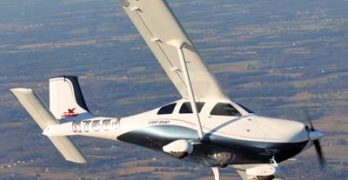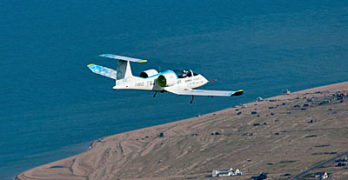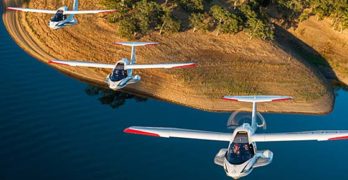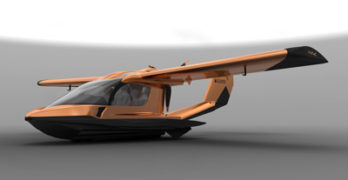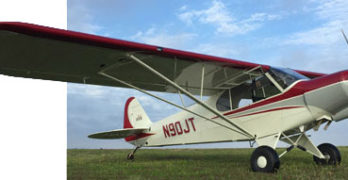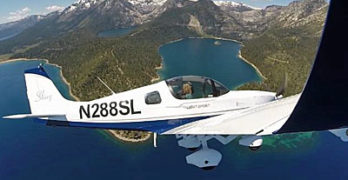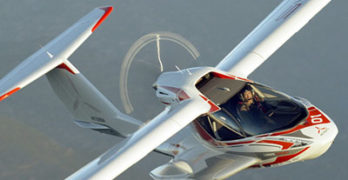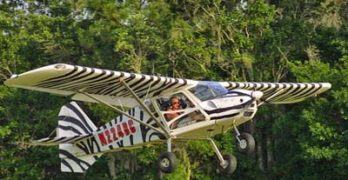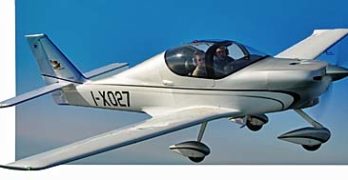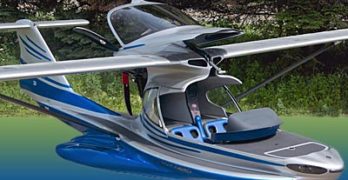We and many other journalists have arrived in EAAworld and are gearing up for another big event. Here are two aircraft announcements of interest and one avionics offering. More will follow.
Jabiru USA has news prices and new gear for their speedy line of kits and LSA. Jabiru USA Sport Aircraft is celebrating ten years in the Light-Sport Aircraft market by offering a new large-screen Garmin G3X Touch avionics package as standard equipment for its J230-D high-performance composite LSA while lowering the price of the fully-loaded aircraft to $119,900. The Australian-designed Jabiru J250/230 series has been flying in the U.S. since 2005 and is known for its speed, easy handling and large baggage capacity.
“By simplifying our overhead, we are now able to offer the new fully-equipped J230-D with the Garmin system for $119,900, a price cut of nearly $20,000,” said Jabiru USA general manager Pete Krotje.
David Versus Goliath … ePlane Channel Crossing
When discussing big versus small, you cannot go much further than comparing a Light-Sport Aircraft company to Airbus. This story speaks to LSA builder Pipistrel, the goal of their French dealer, and nearly identical plans of the giant corporation. In a fascinating development, it turns out that an even smaller entity, a single individual in a miniature flying machine, managed to best the jet airliner producer at its own game. Here’s the story as I understand it although I readily admit I am relying solely on second-hand information.
Pipistrel makes the Alpha Electro (formerly known as WattsUp as our video at the end notes). They’ve already seen some success with this aircraft the factory model of which has been powered by a Siemens motor supplied by the huge Germany company.
As everyone who follows reporting of electric propulsion of either airplanes or electric cars surely knows, “range anxiety” is a consumer problem to be overcome and taking flights demanding courage is one way to assuage those concerns.
Preparing to Test Fly Icon’s A5 … at Last!
The big dogs have been fed. It will soon be time for we smaller critters to get our chance. Icon Aircraft reported that in late June, they hosted reporters from Flying Magazine, Plane & Pilot, AOPA Pilot, EAA Sport Aviation, and the Seaplane Pilots Association’s Water Flying magazine. Those writers got pretty excited by their long-awaited experience in the A5 and I must admit, it has psyched me up as well. Over many years in this trade, I’ve had the pleasure to fly nearly 400 different aircraft, virtually all of them in the same space occupied by A5 yet, even with all that, I’m very much looking forward to my own A5 flight experience coming up just before AirVenture Oshkosh 2015.
You can read about my flight experience on this website and you can presently find plenty of content (articles and video) about A5. No waiting required!
Riding the Wave … Vickers’ Wave, That Is
As I’ve written a few times, I see a dichotomy in LSA designs. Landplanes appear to have entered a “mature” phase, where changes are incremental, evolutionary rather than revolutionary, if you will. I see nothing wrong with that. To the contrary, it speaks to an industry that knows where it is going and how to achieve design goals. Electric propulsion is still stirring things considerably (witness several recent articles here and elsewhere) but electric motors can work on landplanes or seaplanes.
To my view, it appears the lead in the most innovative design is being done in LSA seaplanes. Perhaps this was triggered by Icon and their A5. The California entry is handsome and well enough marketed to collect many orders. While finally coming to market A5 has been a decade in preparation. This left the door open for more highly innovative entries
Meanwhile existing designs such as Searey and Super Petrel have been much refined and have demonstrated meeting ASTM standards with Searey also achieving Chinese Type Design Approval.
Super Duper Legend Cub with 180 Horses!
Whoa, big boy! When you have huge power available, you need to … well, go have fun! I’ve covered the Super Legend before (article & video), which had the multi-fuel, electronic ignition 115-horsepower Lycoming O-235 installed. Certainly that was and remains a solid powerplant but now the company has added a Titan engine that pulls like a team of stallions. Call it the Super Duper Legend Cub.
As sales of Legend Cubs and similar aircraft have shown, pilot interest in Cubalikes is strong. American Legend recently logged their 10th anniversary; they’ve been around since the LSA sector first arrived on the scene. However, they haven’t simply made the same old airplane in the same old way. Now welcome Super Legend HP.
Before Sun ‘n Fun 2015, the Sulphur Springs, Texas company announced they had added, “a host of new features for our Super Legend, adding functionality, comfort and safety to the lineage of Legend Cub aircraft.
Sling News & Video Maker Paul Hamilton
When you deliver an airplane to an accomplished video producer you are bound to get some great photos out of the deal. The images with this article show video impresario (and my longtime friend), Paul Hamilton, flying new Sling N288SL around beautiful Lake Tahoe not far from his home base in Nevada. Paul has been around light aviation for more years that he may be willing to admit. He has long promoted weight shift aircraft and was influential in developing early LSA training documents and videos in addition to making several video productions that were enjoyable to watch.
The Airplane Factory USA boss Matt Liknaitzky wrote, “It was another great showing for the Sling at Sun ‘n Fun 2015 and our team has been busy ever since.” Regarding the new delivery, he added, “In some recent exciting news, another Sling has stretched its wings! N288SL, a brand new Sling [powered by the fuel injected Rotax] 912iS, made the journey to its new home at Paul Hamilton’s Sport Aviation Center at the Carson City Airport (KCXP).
Icon Successfully Completed FAA Audit
Let the production begin! This, um … iconic company in the LSA space has been brewing for a long time, long enough that some aviators have been grumbling, wondering if Icon is “for real.” Today, the company announced that a week ago on June 11th, they successfully completed their FAA audit. That opens the door to serial production of a reported 1,250 orders as announced earlier this year.
In addition, some media persons including yours truly, will get to fly the machine during Oshosh in just a few weeks. I’m excited to see how this well-promoted, long-in-development aircraft flies.
“The successful completion of the FAA’s audit of the A5 is one of the most critical milestones in our company’s history,” said Icon Aircraft CEO and Founder Kirk Hawkins. “This means that after years of intense development by the Icon team, our customers and the media will finally get a chance to experience the A5 firsthand and form their own opinion.
BushCat Available Several Ways, All Affordable
Let’s move right to an important point. BushCat is most interesting aircraft with unique features of interest to many and you are much more likely to afford the South African airplane with its 2015 U.S. price of $65,000. That figure covers the Rotax 100-horsepower 912 engine; you can pay somewhat less with the 80-horsepower that is more than enough engine to give this light aircraft plenty of performance. You could also save more by assembling a kit version of this Special LSA.
However, now BushCat has another feather in its cap, so to say.
SkyReach engineers were able to raise weight from 1,245 to 1,320 pounds by strengthening components like wing strut brackets, then followed by an intense program of flight testing to include an entire regimen of spin testing (the latter representing much more work than many pilots may think). What does this do for BushCat beside bringing its numbers up to the max allowed in the LSA category?
REVISED: World Aviation Statistics with New Data
Revised Article UPDATED: 6/5/15 / New total LSA and LSA-like chart (at bottom) — At best statistics can be fluid and hard to state precisely. In response to my request for any Australian input below, Neil Jansen responded, “I found some data sourced from the authority that manages such aircraft categories in Australia (Recreational Aviation Australia).” He attached a PDF article. After my review of this document, I can say that I was not grossly off in my guesstimate of 2,000 LSA-type aircraft. I attempted to be conservative and evidently I was. From a review of the charts and article, I would now increase my Australia figures from 2,000 to perhaps 2,700 so the final calculus of around 50,000 worldwide aircraft looks even more solid. That said, my European counterpart, Jan Fridrich, and I since had a conversation that suggests even 50,000 may not fully cover it.
MVP.aero’s “Omniplane” Tour
You have to love the English language (or maybe hate it for the same reason): New words keep arriving in conversations. Team MVP used the term “triphibian” to mean a Light-Sport Aircraft seaplane entry that could land on runways, waterways, or snow. Of course, many amphibious seaplanes could make a similar claim so perhaps it took something even better. Enter “Omniplane.” Is this the plane that can do it all?
In May of 2015, MVP.aero went on tour, hitting the west coast area known as Silicon Valley, then traveling over 2,000 miles to Daytona Beach, Florida … as luck would have it, right to my home airport of Spruce Creek (technically in Port Orange, Florida). The airplane was trucked across the country as today it is only a well-traveled mockup while the company raises funds to complete engineering and enter production.
Silicon Valley and Spruce Creek are excellent places to seek investors that understand the magic.
- « Previous Page
- 1
- …
- 4
- 5
- 6
- 7
- 8
- …
- 64
- Next Page »


